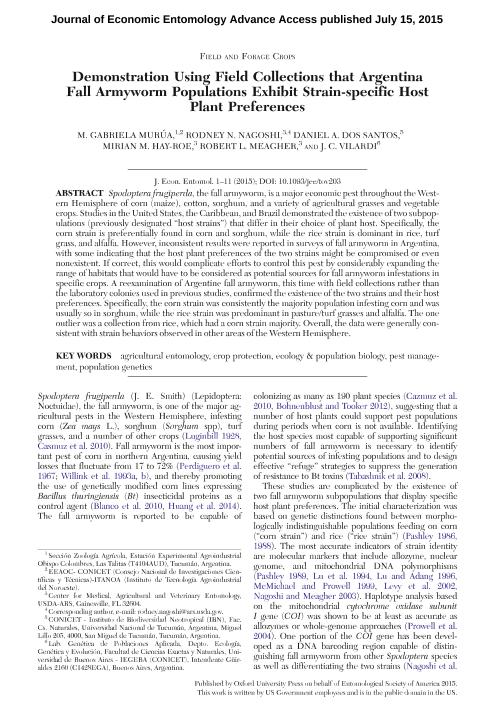Mostrar el registro sencillo del ítem
dc.contributor.author
Murúa, María Gabriela

dc.contributor.author
Nagoshi, Rodney N.
dc.contributor.author
Dos Santos, Daniel Andrés

dc.contributor.author
Hay Roe, Mirian M.
dc.contributor.author
Meagher, Robert L.
dc.contributor.author
Vilardi, Juan Cesar

dc.date.available
2022-07-19T16:18:12Z
dc.date.issued
2015-08
dc.identifier.citation
Murúa, María Gabriela; Nagoshi, Rodney N.; Dos Santos, Daniel Andrés; Hay Roe, Mirian M.; Meagher, Robert L.; et al.; Demonstration using field collections that Argentina fall armyworm populations exhibit strain-specific host plant preferences; Entomological Society of America; Journal of Economic Entomology; 108; 5; 8-2015; 2305-2315
dc.identifier.issn
0022-0493
dc.identifier.uri
http://hdl.handle.net/11336/162534
dc.description.abstract
Spodoptera frugiperda, the fall armyworm is a major economic pest throughout the Western Hemisphere of corn (maize), cotton, sorghum, and a variety of agricultural grasses and vegetable crops. Studies in the United States, the Caribbean, and Brazil demonstrated the existence of two subpopulations (previously designated ?host strains?) that differ in their choice of plant host. Specifically, the corn strain is preferentially found in corn and sorghum while the rice strain is dominant in rice, turf grass, and alfalfa. However, inconsistent results were reported in surveys of fall armyworm in Argentina, with some indicating that the host plant preferences of the two strains might be compromised or even nonexistent. If correct this would complicate efforts to control this pest by considerably expanding the range of habitats that would have to be considered as potential sources for fall armyworm infestations in specific crops. A reexamination of Argentine fall armyworm, this time with field collections rather than the laboratory colonies used in previous studies, confirmed the existence of the two strains and their host preferences. Specifically, the corn strain was consistently the majority population infesting corn and was usually so in sorghum, while the rice strain was predominant in pasture/turf grasses and alfalfa. The one outlier was a collection from rice, which had a corn strain majority. Overall, the data were generally consistent with strain behaviors observed in other areas of the Western Hemisphere.
dc.format
application/pdf
dc.language.iso
eng
dc.publisher
Entomological Society of America

dc.rights
info:eu-repo/semantics/openAccess
dc.rights.uri
https://creativecommons.org/licenses/by-nc-sa/2.5/ar/
dc.subject
AGRICULTURAL ENTOMOLOGY
dc.subject
CROP PROTECTION
dc.subject
ECOLOGY & POPULATION BIOLOGY
dc.subject
PEST MANAGEMENT
dc.subject
POPULATION GENETICS
dc.subject.classification
Otros Tópicos Biológicos

dc.subject.classification
Ciencias Biológicas

dc.subject.classification
CIENCIAS NATURALES Y EXACTAS

dc.title
Demonstration using field collections that Argentina fall armyworm populations exhibit strain-specific host plant preferences
dc.type
info:eu-repo/semantics/article
dc.type
info:ar-repo/semantics/artículo
dc.type
info:eu-repo/semantics/publishedVersion
dc.date.updated
2020-12-04T18:40:00Z
dc.journal.volume
108
dc.journal.number
5
dc.journal.pagination
2305-2315
dc.journal.pais
Estados Unidos

dc.journal.ciudad
Lanham
dc.description.fil
Fil: Murúa, María Gabriela. Consejo Nacional de Investigaciones Científicas y Técnicas. Centro Científico Tecnológico Conicet - Tucumán. Instituto de Tecnología Agroindustrial del Noroeste Argentino. Provincia de Tucumán. Ministerio de Desarrollo Productivo. Estación Experimental Agroindustrial "Obispo Colombres" (p). Instituto de Tecnología Agroindustrial del Noroeste Argentino; Argentina
dc.description.fil
Fil: Nagoshi, Rodney N.. United States Department Of Agriculture. Agriculture Research Service. Unidad Insect Behavior And Biocontrol; Estados Unidos
dc.description.fil
Fil: Dos Santos, Daniel Andrés. Consejo Nacional de Investigaciones Científicas y Técnicas. Centro Científico Tecnológico Conicet - Tucumán. Instituto de Biodiversidad Neotropical. Universidad Nacional de Tucumán. Facultad de Ciencias Naturales e Instituto Miguel Lillo. Instituto de Biodiversidad Neotropical. Instituto de Biodiversidad Neotropical; Argentina
dc.description.fil
Fil: Hay Roe, Mirian M.. United States Department Of Agriculture. Center For Medical Agric And Vet Entomology; Estados Unidos
dc.description.fil
Fil: Meagher, Robert L.. United States Department Of Agriculture. Agriculture Research Service. Unidad Insect Behavior And Biocontrol; Estados Unidos
dc.description.fil
Fil: Vilardi, Juan Cesar. Consejo Nacional de Investigaciones Científicas y Técnicas. Oficina de Coordinación Administrativa Ciudad Universitaria. Instituto de Ecología, Genética y Evolución de Buenos Aires. Universidad de Buenos Aires. Facultad de Ciencias Exactas y Naturales. Instituto de Ecología, Genética y Evolución de Buenos Aires; Argentina
dc.journal.title
Journal of Economic Entomology

dc.relation.alternativeid
info:eu-repo/semantics/altIdentifier/url/http://jee.oxfordjournals.org/content/early/2015/07/15/jee.tov203
dc.relation.alternativeid
info:eu-repo/semantics/altIdentifier/doi/http://dx.doi.org/10.1093/jee/tov203
Archivos asociados
